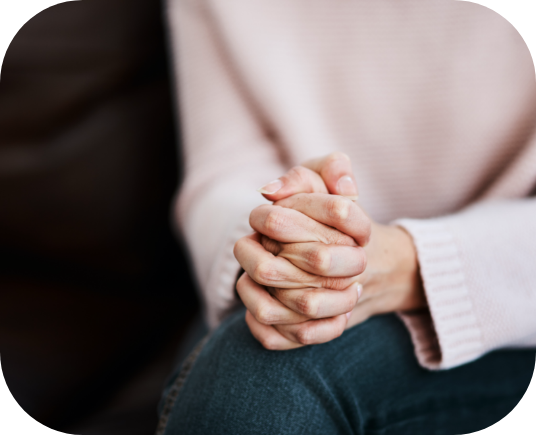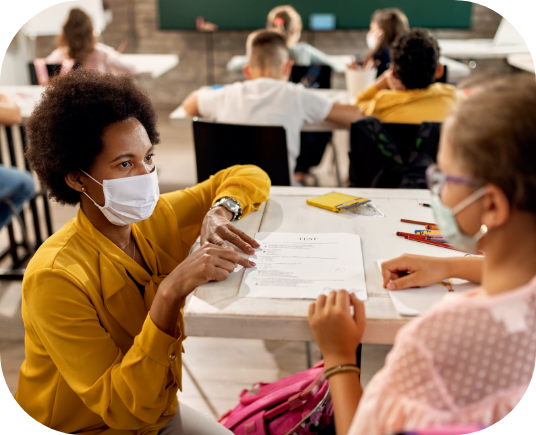

Trauma
What Is it?
Trauma is the enduring emotional response to a disturbing event(s). Trauma is difficult to define because different people have different perceptions of traumatic events. One event may be more traumatic for one person than the other.
Trauma can be caused by:
- A recent event
- An event which happened in the past
- A repeated or long-term pattern of events
These events can happen to the individual personally. They can happen to a loved one of the individual. It can also be experienced by seeing the event (in person, on tv, or social media) or helping a person(s) through a traumatic event.
Myths and Facts
FACT – Trauma is common
Roughly 76% of Canadians will experience at least one traumatic event in their lifetimes.
FACT – Not everyone who experiences trauma will develop post-traumatic stress disorder (PTSD) or other trauma-related issues.
Only 8% of people who experience trauma will develop post-traumatic stress disorder. Trauma does not equal PTSD. If a child or youth experiences trauma, one caring adult can make a difference in how they process it.
FACT – Growth can happen after trauma
With help, people who experience trauma can have post-traumatic growth (PTG). This growth is a positive change where the person can find strength from what they have faced. It can help them gain a feeling of personal growth. This is not the same as resiliency. Resiliency is a personal trait where the person can bounce back after trauma.
PTG is when a person has been rocked to their core by a traumatic event, and after struggling, the person works on and gains personal growth. This growth can lead to a new appreciation of life, positive changes in relationships with others, seeing new possibilities, realizing personal strength, and spiritual growth. It takes work and time. It can make positive changes to improve quality of life.
FACT – Trauma can have a variety of causes.
Many people think trauma must be a big, potentially life-ending event. This is not true. There is colloquial categories of big “T” and little “t” trauma. What does that mean?
Big T trauma is what people typically think of with trauma, like war, terrorism, car accidents, or assault. Trauma is not limited to the Big T. Little t traumas are often overlooked. People rationalize little t trauma. They are considered “common” events. Oftentimes, people do not allow themselves to feel their emotions or react to the event because they do not want to seem unreasonable. Little t trauma can include conflict, moving, break up, or other events which do not threaten the person’s life. It can cause the person to feel helpless.
There are several other kinds of trauma.
- Complex trauma. Complex trauma is multiple traumatic events. These events are often serious in nature.
- Intergenerational trauma. Intergenerational trauma is trauma that has been passed down by previous generations. This means children can be impacted by the trauma of their parents. Children begin to show trauma responses despite not experiencing the trauma firsthand. Some of the responses are learned from parents. Others have been inherited through genetics. The impact of the cultural genocide and residential schools has been felt for generations of Indigenous people. This is intergenerational trauma.
- Vicarious trauma. Vicarious trauma can be challenging to recognize. It is caused by acting compassionately with survivors of trauma and their experiences.
- Secondary trauma. Secondary trauma is when a person hears about trauma experiences. This could also include seeing something on tv or social media.
FACT – Recovery is possible.
Recovery looks different for everyone. Trauma can be overwhelming, and recovery is living in the present moment without being overwhelmed by what happened. Processing trauma takes effort, but it can help the individual to feel better. Working with someone who specializes in trauma can help a person to process the emotions regarding the trauma, help cope with strong emotions, rebuild trust in other people, and dispel the trauma response of fight, flight, freeze, or fawn (more about trauma responses under What Does it Look Like?).
FACT – If trauma is ignored, it will remain unresolved.
Some people think if trauma happens in childhood the person will be able to “bounce back.” The reality is children can be impacted more severely by trauma than adults because they do not have the same coping skills and problem-solving skills. If the trauma is not dealt with, things which remind the person about their trauma will likely trigger emotional responses in the person. Any unresolved trauma can shape how the person views the world and their relationships with others. It can also be passed on to later generations.
Unresolved trauma can impact the individual’s children in later years even if the trauma occurred in the individual’s childhood. If trauma is ignored, it can impact how a person interacts with the world around them. It is important to find someone to help process the trauma.
FACT – A person can have immediate or delayed (or both) reactions to trauma.
A person’s reaction to trauma is influenced by many factors, like their support system, coping skills, experience, community response, and others. Some of the initial reactions to trauma are fatigue, anxiety, agitation, sadness, dissociation, confusion, and nausea or fainting. Delayed reactions can look like shame, issues with sleep, fear, flashbacks, difficulty making decisions, questions, change in a belief system, and hopelessness. Trauma responses are different for everyone. The impact of trauma lasts longer than the event or experience.


Causes of Trauma
As with other mental health concerns, there is not one cause of trauma.
Causes of trauma could include, but are not limited to:
- Abuse
- Intergenerational trauma
- Being removed from the home
- Medical procedures/illness
- Accident
- Neglect
- Violence
- Unsafe environment
- War
- Natural disasters
- Being imprisoned
What Does It Look Like?
Because the causes of trauma can be so different for everyone, the signs of trauma can be as different. What triggers a person’s trauma can depend on the nature of their experiences.
There are four main responses to trauma which are the 4 Fs- Fight, Flight, Freeze, and Fawn. It is also known as Fight, Flight, Freeze, and Appease.
The response depends on the person, their history/experience, and their trauma. There are healthy sides to all of these responses, but they can become unhealthy. These responses are also how we respond to stressful or abrupt changes to our environment.
The 4 Fs were developed as a survival tactic to respond to the dangers in our environment (like how to respond to a sabre-toothed tiger). They are protective mechanisms to deal with threats in the environment. They can become amplified with trauma.

Fight
The fight response is when the person responds to the threat with conflict. They try to fight their way out of the situation and establish power over the threat.
How it can be helpful – setting boundaries and being assertive/courageous when necessary.
What you might see:
- Assertiveness
- Strong leader
- Short-tempered
- Clenched jaw or fists
- Desire to smash something
- Rage or anger
- Intimidating others
- Lying
- Being mean
- Crying
- Bullying others
- Hitting or lashing out
Flight
Flight is when the individual leaves (physically or emotionally) the situation.
How it can be helpful – leaving an unhealthy situation or relationship, removing self from harm, and disengaging harmful situations.
What you might see:
- Restlessness or numbness in limbs
- Shallow breathing or difficulty breathing
- Wide eyes or darting looks
- Fidgeting
- Withdrawing
- Avoiding certain things which remind the person of their trauma
- Sleeping more
- Zoning out or having a tough time concentrating
- Staying busy all the time
- Fear or panic
- Edgy or jumpy
- Dizzy or fainting
Freeze
Freezing is pausing and not acting.
How it can be helpful – keep you from going into dangerous situations
What you might see:
- A person’s mind going blank
- Indecisiveness or a tough time taking action
- Inability to move or feeling stuck
- Holding breath
- Feeling numb
- Confusion
Fawn/Appease
Fawn is trying to please other people to avoid conflict. They will try to make the other person happy to avoid conflict.
How it can be helpful – compromising and having compassion for others.
What you might see:
- Not saying no
- Always going with what others want
- Constantly apologizing
- Ignoring own needs or wants
- Flattering a person excessively
- Going beyond what is expected for others all the time
Some of the other responses could include:
- Flashbacks or intrusive memories of the event
- Fear the event will reoccur
- Nightmares
- Change in belief system
- Racing thoughts
- Change in appetite
- Headaches, digestion issues, body aches, and other physical symptoms related to stress
- Feeling shocked about the event
- Feeling sad, hopeless, guilt, helpless, anger, shame, or relief
- Other mental health issues such as depression, anxiety, or substance use

What to Do if You Are Struggling With Trauma?
If you feel like you are struggling or any of the signs sound like what you are going through, please seek help. Seeking help can sound like an intimidating task and it can seem overwhelming, but it is so important. You deserve to feel better and be happy.
- Tell someone. Tell someone you trust who can help to support you. If you tell someone and they do not listen to you or take you seriously, tell someone else. That is not a reflection on you! You deserve help.
- People you could tell include spiritual leader, elder, family member, friend, counselor, teacher, or coach. Find someone you trust and feel safe around.
- Build a healthy support system. Find people who support and encourage you. This can also include pets! Have people you can talk to when you need it.
- Practice self-care. Self-care is taking time to take care of your own health and wellness. Do (healthy) things which help you feel good!
Check out the Tips for Wellness below or the Wellness Sessions
For more information about wellness, please click here.
For ideas about self-care, click here.
How Can You Help?
When a youth you work with tells you they are struggling, it can be terrifying, and it can be hard to know what to do/say. It is easy to become caught up in emotions. Many of us fear saying the wrong thing. We often want to try to fix their problem or counsel them, but that is not your job. Your main job is to connect your loved one to help.
The following are some guidelines as to what to do when your loved one tells you they are struggling and how to handle those difficult conversations.
This is not to counsel the person. This is to get the person connected with a helping professional. Please remember the conversation will not be exactly like on the page. These are guidelines of some things to consider.
The person is telling you something scary and personal to them. This is terrifying for both of you. Take a moment to gather yourself and take a deep breath. Remember this is about them and their experience. When someone tells us they are struggling, we sometimes react with what seems like anger. This is often an outward display of fear which comes across as anger. This can make it difficult for the person to open up to you.
Take a moment to recognize your own prejudices or judgements about mental health issues. You are entitled to your opinion, but remember this conversation is about the person. It is about their emotions, experiences, and perception. It is all valid and real for them. If you are going to have the conversation, place your judgements or preconceived notions aside to allow for understanding and compassion.
Validate, Encourage, Empower, Refer. (This is not counselling the person. It is connecting them with help.)
Give the person the time and consideration you would like if you were struggling. Be the person you would like helping you in this situation. Give them your full attention. They deserve it. Listening will also help you know what the person is trying to tell you. While you are listening, be understanding and compassionate. Give them the space to talk.
Facing mental health concerns can be very challenging and scary, but your loved one needs help. Without help, the problems can escalate.
Talking to a child/youth who is struggling is challenging. Talk to someone about it to help cope with the stress of the situation. Practice self-care. Do something you enjoy. For self-care ideas, visit the self-care section here.
Sometimes, people are not ready to talk to you. That is okay. It is their choice. Simply let them know you are there to talk if they need someone and give them resources.
Remember VEER
Validate, Encourage, Empower, Refer. (This is not counselling the person. It is connecting them with help.)
Validate – Validating is so important. It is letting the person know what they are feeling is okay. It is acknowledging their emotions as understandable.
For example:
- Yeah, that would be frustrating.
- I am sorry that happened to you.
- It is understandable you feel that way. I would feel that way, too.
- I believe you.
- From what you are saying, I am hearing you are…because of… Is that correct?
Encourage – This is letting the person know they did a good thing by telling you. Talking about mental health struggles can be very challenging. Let them know they are doing the right thing by telling you.
For example:
- Thank you for telling me. That must have been challenging.
- You did the right thing by telling me.
- I am here for you.
Empower – Struggling with mental health issues can be overwhelming, so it is important to let the person know there is help and they can feel better.
For example:
- I know things seem really overwhelming, but there are resources and people to help.
- Let’s find some things which can help you feel better.
- You deserve to feel happy! We will find a way to get there.
Refer – Connect the person with help. They deserve to feel happy and healthy again. There are resources to help them. Your loved one needs to get help. This is not something you can deal with without professional help. Help the person think of someone they trust/who they would like to talk to about their challenges. Everyone connects with a different type of help. Give your loved one options, like a doctor, individual counselling, group counselling, a spiritual leader, or an elder. You can also offer them some helplines they can call when they are struggling, too.
For example:
- Here are some phone numbers you can call when you feel like you need someone to talk to.
- Let’s look up some resources and see what you like best.
- There are many options of people you can talk to. We could talk to the doctor, find a counsellor, or elder. What would you be most comfortable with?
How to Talk to Someone About Their Mental Health?
If you have a feeling something is going on, have a conversation with the person if you feel comfortable talking to them. (If you do not feel comfortable, that is okay. You just need to tell someone who will have the conversation with them and connect them with help).
The following are some guidelines of what to do if you suspect someone is suicidal or not doing well. This is not to counsel the person. This is to get the person connected with a counsellor, doctor, or another professional. Please remember the conversation will not be linear like on the page. These are guidelines of some things to consider.
Before You Have the Conversation:
- Make sure you have time for it
- You are in a place the person will feel comfortable talking to you
- Approach the situation with compassion
- Make sure you are willing to listen
- Remember you can initiate the conversation and let them know you are there, but it may take some time before they talk to you.
1. Take notice. If you feel like something is going on with someone, there likely is something. Trust that gut instinct.
2. Talk to them. Open the conversation in a nonjudgemental and compassionate way. Start off by stating a change you have noticed. Use “I” statements so it does not feel like you are accusing them.
- Example: “Hey, I have noticed you have been cancelling plans lately. How are you doing?” or “I heard you putting yourself down in class. What’s been going on?”
3. Remember VEER Validate, Encourage, Empower, Refer. (This is not counselling the person. It is connecting them with help).
4. Do not ignore it. Facing mental health concerns can be very challenging and scary, but your loved one needs help. Without help, the problems can get worse.
5. Get help for you, too. Talking to a child/youth who is struggling is challenging. Talk to someone about it to help cope with the stress of the situation. Practice self-care. Do something you enjoy. For self-care ideas, visit the self-care section here.
The child/youth may not be ready to talk, and that is okay. Let them know you are there to talk whenever they are ready. You can give them numbers to helplines for support.
Follow-up Support for Someone Coping With Trauma
Teachers
- Adopt a trauma-informed mindset. Click here for a trauma-informed course
- Create a safe environment
- Be aware of the signs of trauma
- Seek help if you need it

Things to Avoid
- Comparing mental health journeys
- Everyone’s mental health journey is different.
- Blaming the person for what happened to help
- Mental illnesses are not personal flaws. There are times when the person may not have the capacity to do certain things.
- Downplaying the person’s experience
- “At least…” This is a common statement. While it is well-meaning, it downplays the person’s experience. It implies the person should be grateful or happy it is not worse. The person has a right to be upset. They have a right to feel their emotions.
- Toxic positivity
- Practicing gratitude is a wonderfully beneficial thing to do and can help improve mood and mental health, but the sunshine outlook can sometimes take a dark turn. Toxic positivity is reframing the situation (even tragic ones) in a positive light. This is the “at least…” or “it could be worse…” It is not letting ourselves (or others) feel uncomfortable emotions.
- It is okay to feel upset about something. It is okay to not be okay, but toxic positivity suppresses any of those emotions. Positive outlooks can be a wonderful thing, but not when it comes at the expense of coping with emotions and difficult situations.
- Pushing your values and beliefs on the person
- They are their own person with a right to make their own choices, and what might work for you might not work for someone else.
- Ignoring the situation
- When a situation is challenging, avoidance might seem like the answer. The person needs help.
- Expecting immediate change.
- Recovery takes time
- Criticizing or judging the person
- Threatening the person
- Making the individual’s mental health struggles about you.
- Counselling the person
Tips for Wellness
In addition to seeking professional help, there are some things you can do to support your mental wellness:

- Remember your feelings are valid. In dealing with trauma there is not a correct or incorrect way to feel. Everyone deals with their trauma differently.
- Feel your feelings. Ignoring your feelings will only delay your recovery. Ignoring them will not make them go away. Emotions will pass when you allow yourself to feel them.
- Live your life. With help, work to gain balance in your life and avoid repeatedly reliving the trauma.
- Be mindful of what type of media you watch and consume. Reduce media exposure of the event or other distressing images.
- Volunteering or connecting with others can help increase feelings of connection and reduce feelings of helplessness.
- Exercise or practice an activity with mind-body activities, like yoga.
- Practice self-care, like sleeping well, eating well, hobbies, and relaxation techniques.
Further Resources
3 Reasons You Can’t Ignore Trauma | Psychology Today Canada
Complex Trauma | The National Child Traumatic Stress Network (nctsn.org)
Different Types of Trauma: Small ‘t’ versus Large ‘T’ | Psychology Today Canada
Emotional and Psychological Trauma – HelpGuide.org
Emotional and Psychological Trauma – HelpGuide.org
Emotional and Psychological Trauma – HelpGuide.org
How to Cope with Traumatic Events – HelpGuide.org
How to Cope with Traumatic Events – HelpGuide.org
Intergenerational Trauma (nbcc.ca)
Phases of Trauma Recovery | Trauma Recovery (trauma-recovery.ca)
Secondary Traumatic Stress | The National Child Traumatic Stress Network (nctsn.org)
The 4 Types of Trauma Responses | Lifestance Health
The Effects of Trauma Do Not Have to Last a Lifetime (apa.org)
Toxic positivity: Definition, risks, how to avoid, and more (medicalnewstoday.com)
Traumatic Events: Causes, Effects, and Management (healthline.com)
Vicarious trauma: signs and strategies for coping (bma.org.uk)
If you would like to speak to someone about mental health issues, the Alberta Health Services Mental Health Help Line is available 24/7, offering information and referrals on any aspect of mental health.
Call toll-free: 1-877-303-2642
Trending Topics
Depression
Depression What Is It? Depression is a mood disorder which means it impacts how a person is feeling. It can cause a person to feel
Accidental Overdose
Accidental Overdose What Is it? An overdose is what happens to someone’s body when they take too much of a substance or too many substances.
Online Relationships
Online Relationships Online can be fun! There are games, music, and videos. We can talk to friends and family online. Tips for Being Safe Online:
Online Relationships
Online Relationships Online can be fun! There are games, music, and videos. We can talk to friends and family online. Tips for Being Safe Online:

